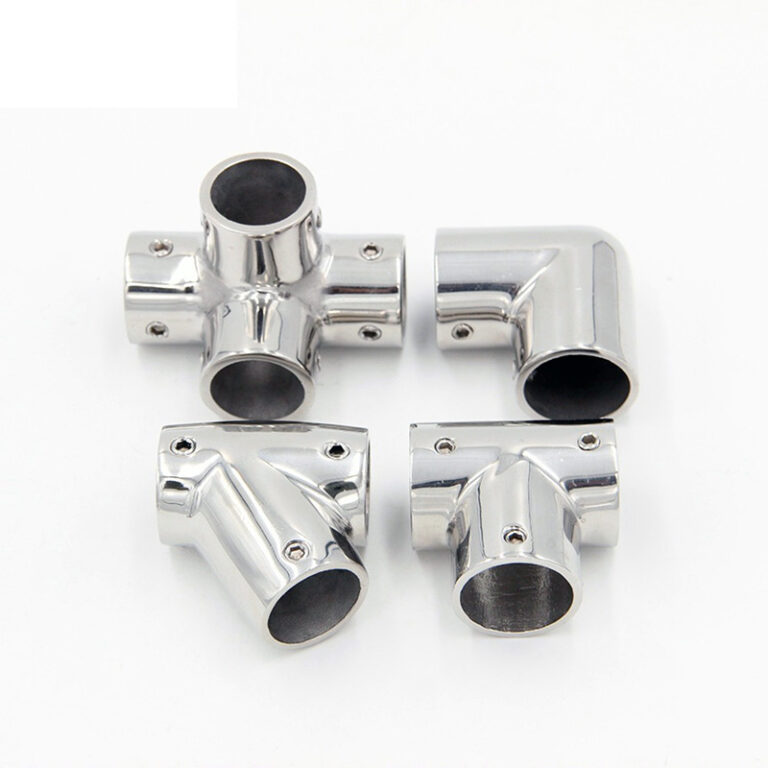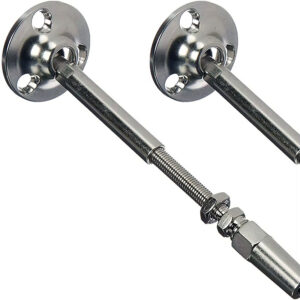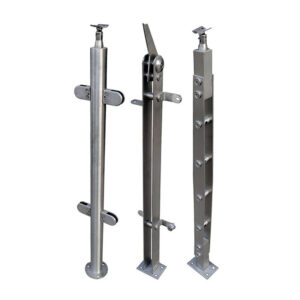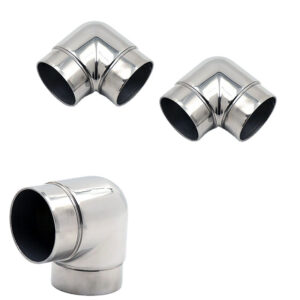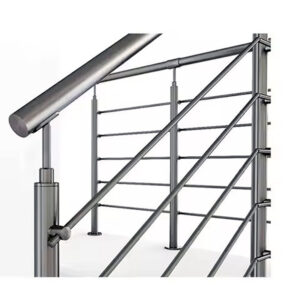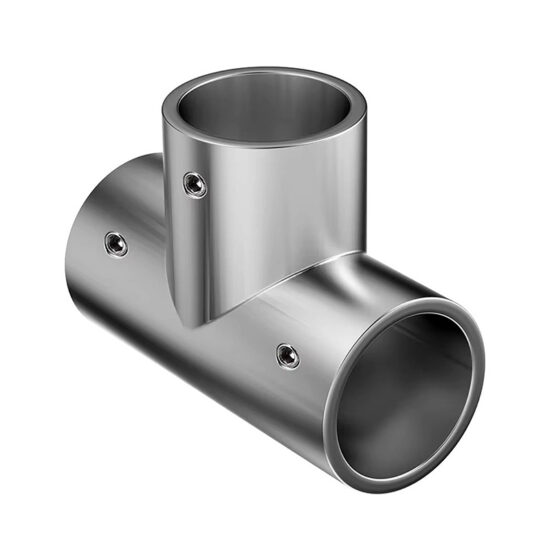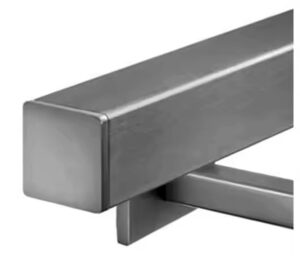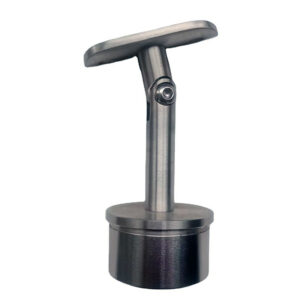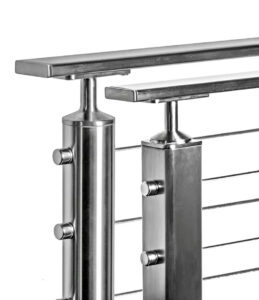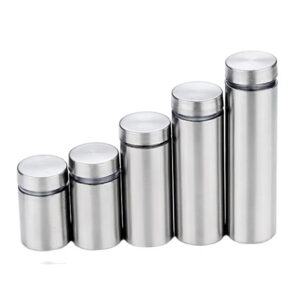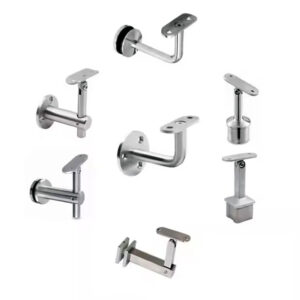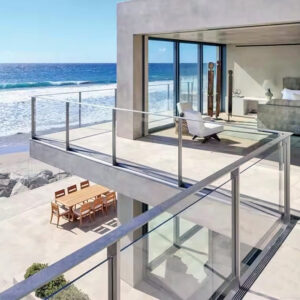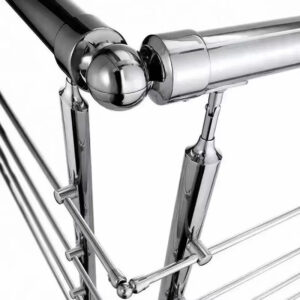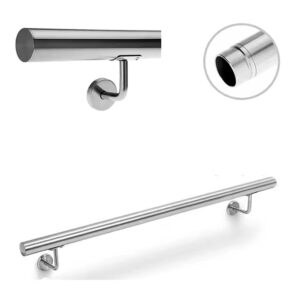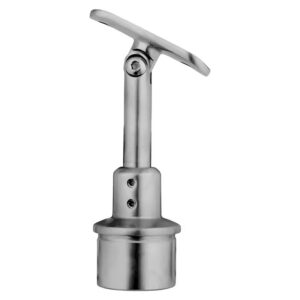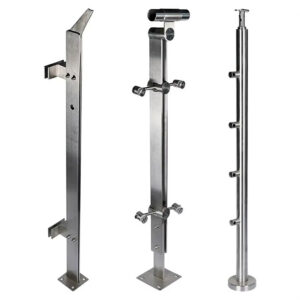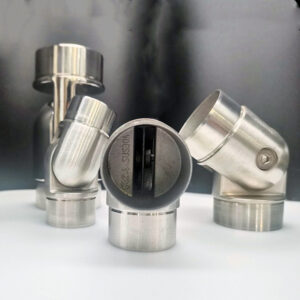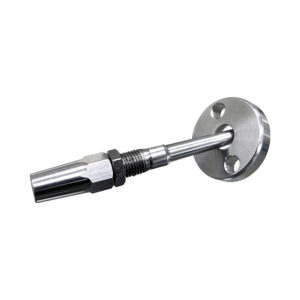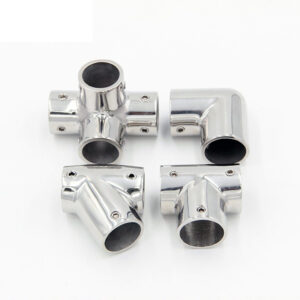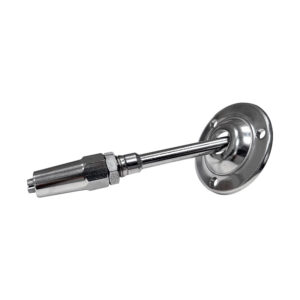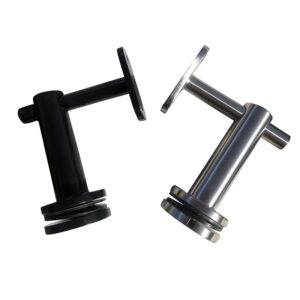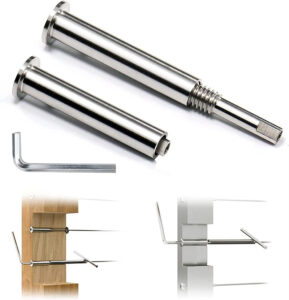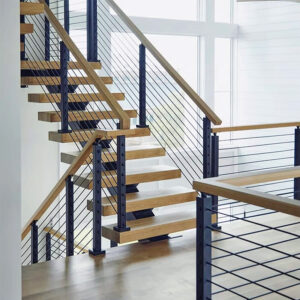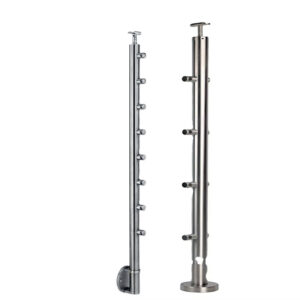Corner connections make or break railing systems. After 23 years of manufacturing stainless steel railing hardware, we’ve seen projects delayed by corners that don’t fit, fail inspection, or require expensive field modifications. The challenge isn’t just making a 90-degree connection—it’s creating corner systems that meet code requirements, install efficiently, and perform reliably over decades of service.
Corner Systems That Actually Work
Welded Corner Assemblies
Pre-fabricated 90 degree rail corners eliminate field welding and reduce installation time by 60%. Available in 304 and 316 stainless steel with brushed or mirror finishes. Standard configurations handle 42″ and 36″ rail heights with integrated mounting provisions. Load ratings meet IBC requirements for concentrated loads up to 200 lbs applied horizontally.
Modular Corner Connectors
Mechanical corner systems use precision-machined connectors that join straight rail sections at exact 90-degree angles. No welding required—components bolt together with stainless hardware. Particularly effective for 90 degree corner fabrication 316L applications where field welding isn’t practical. Standard connectors accommodate 1.5″, 2″, and 2.5″ OD round rails plus rectangular profiles.
Adjustable Corner Hardware
Variable-angle corner brackets handle situations where “90 degrees” isn’t exactly 90 degrees. Field-adjustable from 85° to 95° to compensate for construction tolerances. Critical for commercial installations where corners must align with existing architecture while maintaining code compliance.
Glass Panel Corner Systems
Corner-specific clamps and connectors designed for glass railing installations. Manage the structural loads while accommodating thermal expansion of glass panels. Marine grade corner connectors ODM capabilities ensure compatibility with architectural glass specifications and seismic requirements.
Material Selection Reality
304 stainless handles most interior and standard exterior applications. 316 grade essential for coastal environments, chemical exposure, or extended service life requirements. Our 23 years of experience shows 316L performs consistently in marine environments where 304 fails within 5-7 years.
Surface Treatment Impact
Brushed finishes hide minor scratches and fingerprints—practical for high-traffic areas. Mirror polish provides maximum corrosion resistance but shows every mark. Match surface treatment to maintenance capabilities and aesthetic requirements.
Technical Specifications
| Corner Type | Load Rating (lbs) | Material Options | Installation Time | Applications |
|---|---|---|---|---|
| Welded Assembly | 200 concentrated | 304/316 SS | 15 min per corner | Permanent, high-load |
| Mechanical Connector | 175 concentrated | 304/316 SS | 8 min per corner | Modular, adjustable |
| Adjustable Bracket | 150 concentrated | 316 SS standard | 12 min per corner | Variable angles |
| Glass System | 125 concentrated | 316L + gaskets | 20 min per corner | Architectural glass |
| Material Grade | Corrosion Resistance | Cost Premium | Recommended Use |
|---|---|---|---|
| 304 Stainless | Good (interior/mild exterior) | Standard | Most commercial applications |
| 316 Stainless | Excellent (coastal/harsh) | +25% | Marine, chemical exposure |
| 316L | Superior (welding/stress) | +35% | Critical structural connections |
▶ Get Detailed Specifications ◀
Real Applications, Measured Results
Commercial Office Buildings
Recent 15-story office installation used modular corner connectors throughout. Reduced corner installation time from 45 minutes (field welding) to 8 minutes per connection. Total project time cut by 3 days. No field welding eliminated hot work permits and associated delays. Commercial 90 degree systems performed flawlessly through initial occupancy and first-year inspection.
“Modular corner systems cut our railing installation schedule by 30% while improving quality consistency.” —Commercial Contractors Association
Residential Multi-Unit Housing
Standard welded corners for 240-unit complex provided cost-effective solution. Pre-fabrication ensured consistent quality across all buildings. Field crews installed corners 60% faster than site-welded alternatives. Standardization reduced inventory complexity and eliminated corner-specific tooling requirements.
Marine Installations
Coastal boardwalk project specified 316L corners for 20-year service life. After 8 years, corners show minimal corrosion with no structural degradation. Comparable 304 installation nearby required replacement after 6 years. Premium material cost justified by extended service life and reduced maintenance.
Industrial Facilities
Manufacturing plant used adjustable corner hardware to accommodate building settlement and thermal expansion. Corners remain properly aligned after 5 years despite 2″ building movement. Standard rigid corners in similar facilities required replacement or modification within 3 years.
Load Testing Results
Independent testing confirms our corner assemblies exceed IBC concentrated load requirements by minimum 25% safety margin. Ultimate failure loads typically 300+ lbs for standard residential applications, 400+ lbs for commercial-grade assemblies.
▶ Discuss Your Project Requirements ◀
Installation and Custom Manufacturing
Pre-Fabrication Advantages
Factory-welded corners provide consistent penetration and appearance impossible to achieve in field conditions. Controlled environment ensures proper heat treatment and stress relief. Quality control catches issues before installation, not during final inspection.
Field Assembly Process
Modular systems require standard tools—no specialized equipment or certified welders. Components arrive pre-fitted with installation hardware included. Clear assembly instructions eliminate guesswork and reduce training requirements.
Custom Corner Manufacturing
23 years of fabrication experience enables custom corner solutions for unique architectural requirements. ODM capabilities include non-standard angles, special materials, integrated mounting features, and compatibility with existing systems. Custom corner manufacturing typically adds 2-3 weeks to standard delivery schedules.
Quality Control Standards
All corners undergo dimensional inspection, weld quality testing (welded assemblies), and surface finish verification. Mechanical assemblies tested for proper fit and specified torque values. Batch documentation ensures traceability and consistent performance.
Precision Corner Hardware
Machining tolerances held to ±0.005″ for critical dimensions. Corner angles accurate to ±0.5 degrees. Surface finish consistency maintained across production batches. Precision manufacturing reduces installation problems and ensures long-term performance.
▶ Discuss Custom Requirements ◀
Frequently Asked Questions
Which corner type works best for my application?
Welded assemblies for permanent installations requiring maximum strength. Modular connectors for systems requiring future modification or where field welding isn’t practical. Adjustable hardware for situations with construction tolerance issues or building movement concerns.
How do I specify material grade correctly?
304 stainless for most interior and standard exterior applications. 316 grade for coastal environments (within 5 miles of salt water), chemical exposure, or food service areas. 316L when corner fabrication involves welding or high-stress applications require superior corrosion resistance.
What’s realistic for installation time?
Welded assemblies: 15 minutes per corner including alignment and securing to structure. Modular connectors: 8-12 minutes depending on rail configuration. Field welding corners typically requires 45+ minutes plus cool-down time and finish work.
How do corners affect code compliance?
Corner connections must transfer loads between rail sections without reducing system strength. Our assemblies meet IBC concentrated load requirements (50 lbs/sq ft uniform plus 200 lb concentrated). Proper corner design prevents weak points that cause system failure.
What about thermal expansion in long runs?
Corners must accommodate expansion/contraction in connected rail sections. Fixed corners work for runs under 40 feet. Longer installations require expansion provisions or adjustable corner hardware to prevent stress buildup and connection failure.
Can corners be modified after installation?
Welded assemblies require cutting and re-welding for angle changes. Mechanical connectors allow field adjustment within design limits. Adjustable hardware provides ±5 degree modification capability. Plan for future changes during initial design phase.
Market Positioning and Selection Criteria
| Provider Type | Strength | Limitation | Best For |
|---|---|---|---|
| Esang Metal | 23-year experience, precision manufacturing | Custom solutions require lead time | Quality-focused projects |
| Standard Suppliers | Wide availability, competitive pricing | Limited customization options | Basic applications |
| Local Fabricators | Quick turnaround, local support | Quality/consistency varies | Simple modifications |
| Import Options | Low cost, volume availability | Quality control challenges | Price-sensitive projects |
Selection Criteria by Project Type:
- Critical Safety Applications: Prioritize proven performance and quality control over initial cost
- High-Volume Projects: Balance standardization benefits with customization requirements
- Coastal/Marine Environments: Material selection impacts long-term costs more than initial pricing
- Fast-Track Schedules: Pre-fabricated solutions eliminate field delays and quality variables
“Corner connections represent 15% of hardware cost but cause 40% of installation problems when not properly specified.” —Building Hardware Research Institute
▶ Connect with Our Technical Team ◀
Working with corner challenges for 23 years taught us that successful corner systems balance structural requirements, installation practicality, and long-term performance. Whether you need standard solutions or custom corner manufacturing capabilities, focus on proven systems that eliminate common problems rather than creating new ones. The right corner hardware installed correctly performs invisibly for decades—exactly what reliable infrastructure should do.
